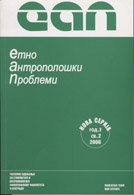Kulturna biografija grandiozne mode: Priča o kolekciji Vitraž Aleksandra Joksimovića
Cultural Biography of Haute Couture: the Story of Aleksandar Joksimović's Vitraž Collection
Author(s): Danijela VelimirovićSubject(s): Customs / Folklore, Recent History (1900 till today), Politics and society, Cultural Anthropology / Ethnology
Published by: Филозофски факултет, Универзитет у Београду
Keywords: "official socialist clothes"; "grandiose exoticism";fashion in "national style"; commoditization; singularisation;
Summary/Abstract: The term "grandiose pseudo-clasicism", introduced to the study of fashion in socialism by Djurdja Bartlett, does not hold ground in the case of Yugoslav/Serbian offical fashion industry. Instead, I claim that a more appropriate term would be "grandiose exoticism", since Yugoslav/Serbian fashion did not build its identity on the pseudoclassical esthetical models, but on the incorporation of exotic motives and patterns form the national thesaurus. "Grandiose exoticism" was a part of the wider project of "national-style" fashion that dominated the history of Yugoslav/Serbian fashion during the 1960s. This form of fashion production was a convenient means for the presentation of Yugoslav idiosyncrasies. Since it corresponded with the characteristics of the social and political milieu of the Yugoslav state, "national-style" fashion symbolically represented the aspects of the identity of Yugoslavia as a socialist and non-aligned country. Therefore, the socialist regime gave a highly representative and commercialized role to grandiose exoticism, as an exclusive style in national fashion. However, in the domain of everyday practices, exclusive fashion production was denied high cultural value, since its products were subjected to processes of commoditization and exchanged for very low sums of money. Parallel to the processes of commoditization, there was the process of informal singularisation carried out by groups who had access to warehouse stocks of haute couture. Unfortunately, the lack of data on the further cultural biography of these objects disables us to fully study the destiny of exclusive pieces of Yugoslav fashion production in socialism.
Journal: Етноантрополошки проблеми
- Issue Year: 1/2006
- Issue No: 2
- Page Range: 91-104
- Page Count: 14
- Language: Serbian

